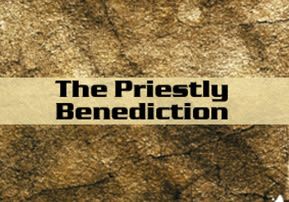
Shmini: The Priestly Benediction
The Priestly blessing is part of the Temple service, and at the same time, reflects the Kohen's interaction with the people...

Translated and abridged by Rabbi Chanan Morrison
Parshat Shmini
The Tabernacle inauguration concluded with a blessing from the High Priest:
"Aaron lifted his hands towards the people and blessed them. He then descended from preparing the sin offering, the burnt offering, and the peace offerings." (Lev. 9:22)
When Was the Blessing Recited?
From the Torah's account, it would seem that Aaron blessed the people before he completed the service in the newly dedicated Tabernacle. The Sages, however, explained that the actual order was different. First, Aaron completed the offerings and descended from the altar. Only afterwards did he bless the people (Torat kohanim; Megillah 18a).
If the priestly benediction was performed at the end of the Temple service (which nowadays is recited at the  end of the Amidah prayer), why does the Torah imply a different order?
end of the Amidah prayer), why does the Torah imply a different order?
The True Honor of kohanim
When discussing the contribution of the kohanim to the Jewish people, and the corresponding honor they receive, we must distinguish between their current state and their future potential.
We may respect an individual kohen for his scholarship and piety, but the true honor we bestow to kohanim is in recognition of their holy influence over the entire nation. We honor them primarily for their future potential, for what a kohen should and can be — 'for he is an emissary of God of the hosts' (Malachi 2:7). Even if the kohen is undeserving of such honor in his present state, 'You must strive to keep him holy… he will be holy for you, since I am holy' (Lev. 21:8). His holiness is due to his potential benefit to the nation, as a member of the sanctified family.
(This, by the way, is similar to the honor we give to rabbis and teachers. We respect them for their erudition and also as representatives of the institution of the rabbinate. This honor is in recognition of the overall contribution of the rabbinate to the welfare of the people. The rabbi on his part should realize that he is primarily honored for what he ought to be, and should do his best to fulfill this expectation.)
Two Roles of the Priesthood
The function of the kohanim is not only to serve in the Temple. The kohanim are also expected to teach and elevate the people, as it says, "From the kohen's lips they will guard knowledge, and they will seek Torah from his mouth" (Malachi 2:7). These two roles are interrelated, since the source for their spiritual influence on the people originates in the holiness of their service in the Temple.
There is one duty of the kohanim that combines both of these roles: the priestly blessing. This blessing is part of the Temple service, and at the same time, reflects their interaction with the people. The kohanim recite the blessing with outstretched arms, a sign that their efforts to uplift the people are an extension and continuation of their holy service in the Temple.
Bridging the Past and the Future
The blessing also forms a bridge over time, connecting the past with the future and the actualized with the potential.
The kohanim can best fulfill their mission to uplift the people after they have participated in the Temple service and experienced the unique elevation of soul gained through this holy public service. Their blessing will then reflect the highest level of influence and inspiration the kohen is able to impart. Thus, the blessing indicates the present state of the kohen, while being based on his past service, and extending — like his outstretched arms — to his future potential influence.
Now we can resolve the apparent contradiction between the Torah's account and actual practice. The text implies that the kohanim complete their service after blessing the people. The service referred to here is not their service in the Temple, but their role in uplifting the people, which is truly their primary mission. In practice, however, the priestly blessing needs to be based on the holy services that they have already performed. Therefore, it is recited only after they have completed their service in the Temple.
The Impact of Prayer
A similar phenomenon is found at the end of the Amidah prayer, when we say, "May the words of my mouth and the thoughts of my heart be acceptable before You" (Psalms 19:15).
It would appear more logical to recite this plea before praying. In fact, the verse does not refer to the prayer about to be recited, but to our heartfelt aspiration that we should be able to apply the influence of this prayer on the coming day. Like the priestly benediction, this request forms a bridge between two states. It is based on the prayer service just performed, but it looks forward to the future influence of this spiritual elevation on our lives.
(Gold from the Land of Israel pp. 187-189. Adapted from Olat Re'iyah vol. I, pp. 284-285; Otzerot HaRe'iyah vol. II, pp. 211-212)
* * *
Rabbi Chanan Morrison of Mitzpeh Yericho runs http://ravkookTorah.org, a website dedicated to presenting the Torah commentary of Rabbi Avraham Yitzchak HaCohen Kook, first Chief Rabbi of Eretz Yisrael, to the English-speaking community. He is also the author of Gold from the Land of Israel (Urim Publications, 2006).












Tell us what you think!
Thank you for your comment!
It will be published after approval by the Editor.